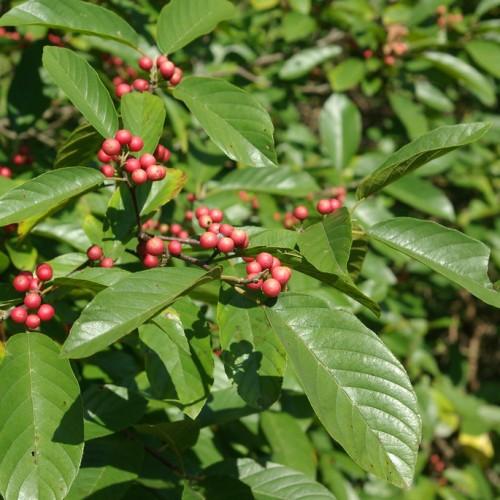
Carolina buckthorn
Frangula caroliniana
Cycle:
Perennial
Watering:
Average
Hardiness Zone:
5 - 9
Flowers:
Flowers
Sun:
Full sun,part shade
Fruits:
Fruits Ready In Fall
Leaf:
Yes
Growth Rate:
Low
Maintenance:
Low
Poisonous To Humans:
Yes
Poisonous To Pets:
Yes
Drought Tolerant:
Yes
Thorny:
Yes
Invasive:
Yes
Care Level:
Medium
watering
Carolina buckthorn requires regular watering to ensure successful growth. Generally, the soil should be kept lightly moist but never soggy. Water when the top 2-3 inches of soil are dry and provide enough to thoroughly soak the root ball. During the growing season, water about once or twice a week, depending on outdoor temperature and humidity. This should be reduced during Winter months when growth is much slower. In hotter climates, make sure not to let the plant dry out completely. Over-watering can lead to root rot, so it's important to also ensure that your soil has good drainage.
sunlight
Carolina buckthorn requires full sun to thrive. It needs at least 6 hours of direct sunlight each day in order to flower and set fruit. This species is not sensitive to drought, but it may need additional watering in arid regions. It prefers cool mornings and shade in the later afternoon for best growth. The ideal location would have the Carolina buckthorn in full sun for most of the day, but with some afternoon shade.
pruning
Carolina buckthorn should be pruned in late spring to early summer after the new growth has appeared. Pruning should be light, removing dead or damaged branches, and removing any fast growing shoots that could become a safety hazard. A well placed cut to shape the hedge and to maintain a manageable size is recommended. To maintain the desired size and shape, recurring pruning and trimming is necessary. Prune lightly during the growing season, about halfway up the branch. Prune more heavily in late winter and early spring, after the main flowering period. Be sure to eliminate any dead or diseased branches to help prevent any diseases from spreading.
